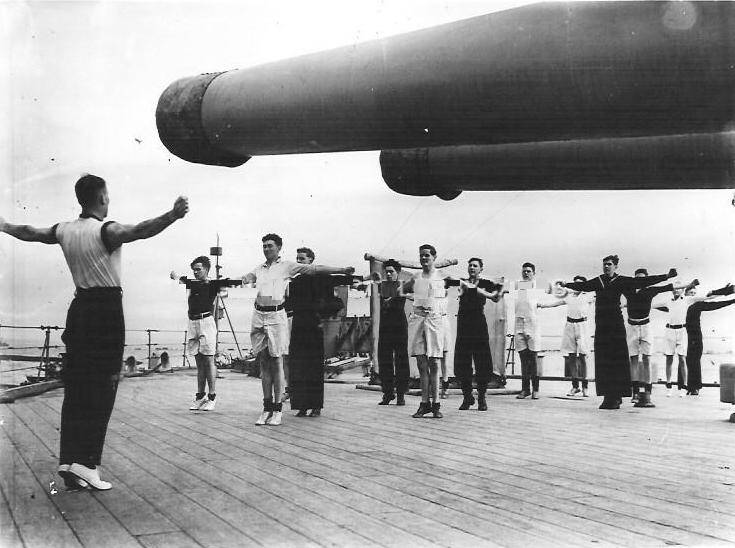
The Royal Navy: Mediterranean Squadron

Figure 1.--"HMS Malaya" was a World War I battleship involved in the Meditteranean canpasign. It was primarily used for convoy esort duty. The caption for this Admiralty photograph read, "Wire service photograph read, 'HMS Maslasya: Part of the Boy's Dividionat P.T. exercise on board HMS Malaya.' We beliee the Boy's Division referred to the younger emlisted men (ratings). They are exercising under the ship's 15-inch guns.
|
|
The Mediterranean was a traditional focus of the Noyal Navy because it was the connection with India and the rest of the Empire. Italy's entrance into the War brought important asetts into the NAZI war effort which could be arrayed against Britain. It also meant, however, that Britain was able to bring its greatest assett, the Royal Navy, to bear against the Axis. The British controlled the two entances to the Mediterranean (Suez and Gibraltar) and Malta provided a critical base in the center. The fall of France, however, meant that the French fleet was taken out of the Mediterranean equation. The British and French fleets combined provided the Allies naval superority. Without the French fleet, however, the Italian fleet on paper looked on paper as the dominant force. The Admiralty considered evacuating Malta and withdrawing from the Mediterranean, but in the end decided to strenghen the Mediterranean Squadron and hold Malta. The Royal Navy at the time was hard pressed and only a limited number of units cold be committed to the Mediterranean. When the Italians land invasion of Egypt faltered (December 1940), they were bolstered by German first by the Luftwaffe and then by Rommel's Afrika Corps (March 1941). The Mediterranean Squadron had two primary tasks. One, to destroy the Italian fleet. Two, to deny supplies to Rommel's Afrika Korps. Vice-Admiral Sir Andrew Cunningham took command of the Mediterranean Squadron ( 1939). He commanded from HMS Warspite. The major formations were the 1st Battle Squadron, 1st Cruiser Squadron, 3rd Cruiser Squadron, Destroyers, and the aircraft carrier HMS Glorious. Cunnigham was outnumbered and outgunned by the Italian Royal Navy. Cinningham's plan was to hold the three decisive strategic bases (Gibraltar, Malta, and the Suez Canal) and fighting it out with the Italians. Malta was the lynch-pin of the British position and vital for interdicting supplies to the Afrika Korps.
CIH -- WW II

Navigate the Boys' Historical Clothing Web Site:
[Return to Main World War II Mediterranean naval campaign page]
[Return to Main World War II Atlantic naval campaign page]
[Return to Main World War II page]
[About Us]
[Aftermath]
[Biographies]
[Campaigns]
[Children]
[Countries]
[Deciding factors]
[Diplomacy]
[Geo-political crisis]
[Economics]
[Home front]
[Intelligence]
[Military forces]
[POWs]
[Resistance]
[Race]
[Refugees]
[Technology]
[Totalitarian powers]
[Bibliographies]
[Contributions]
[FAQs]
[Images]
[Links]
[Registration]
[Tools]
[Return to Main World War II page]
[Return to Main war essay page]
[Return to CIH Home page]
Created: 3:12 AM 12/7/2009
Last updated: 3:12 AM 12/7/2009



